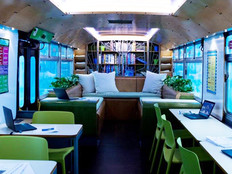How Wearables and Virtual Reality are Finding a Place in the Classroom
From across the room, a teacher writes on the digital whiteboard with a wave of her hand. BIRD, a ring-like device from MUV Interactive that transforms any surface into a multitouch interface, is taking wearable technology to a new level.
Israeli entrepreneur Rami Parham built the first prototype of BIRD in his parents’ basement.
“He devised the idea that people should be able to interact with digital media just by moving their fingers,” explains Daniel Star, vice president of business development at MUV Interactive.
After a few years of development and testing, BIRD is taking flight this spring as a commercial product. Its 100-foot range means teachers can control digital whiteboards while mingling with students. “It allows teachers to take full advantage of remote touch and interaction,” says Star. “From across the room, you can click, touch, turn up the volume, annotate something, or bring up a page from the web.” Teachers can master it in about 15 minutes, he says.
BIRD is part of a vast future of wearble virtual reality devices in the classroom. Analysts at New Media Consortium predict wearables will be widespread in classrooms in about four years, but there are already examples of the technology making waves in education.
Embracing VR in the Classroom
Other products focused on immersive learning include Google’s Glass and Cardboard and Microsoft’s HoloLens. While Google has cut production of Glass for consumers, elementary teacher Margaret Powers still uses it in the classroom at Episcopal Academy, in Newtown Square, Pa., where she serves as technology coordinator.
“My primary goal is to explore how it could be a tool for video documentation, especially for really young kids,” Powers says. “I’ve had kids capture what they’re experiencing, especially tactile, hands-on activities, and it’s interesting to see what their learning experience is like.” Star sees BIRD as part of the developing virtual reality market.
“If projections are made on the four walls, you can actually touch the air and have an immersive experience,” he says.
Google Cardboard, on the other hand, appears to be taking off.
What Does the Future Hold for Wearable Tech?
“We’re in a novice stage, so there’s a lot that we’ll see change and be released in the next few years,” Powers says. “My hope is the development of wearables will make the learning process more dynamic and specific to every student’s needs.”
Stan Silverman, professor of Instructional Technology at New York Institute of Technology, foresees myriad uses for wearables.
“Students will work in collaborative teams, constructing and deconstructing objects, analyzing and visualizing data in 3D, and exploring virtual worlds from the subatomic level to the galactic level,” he says.









